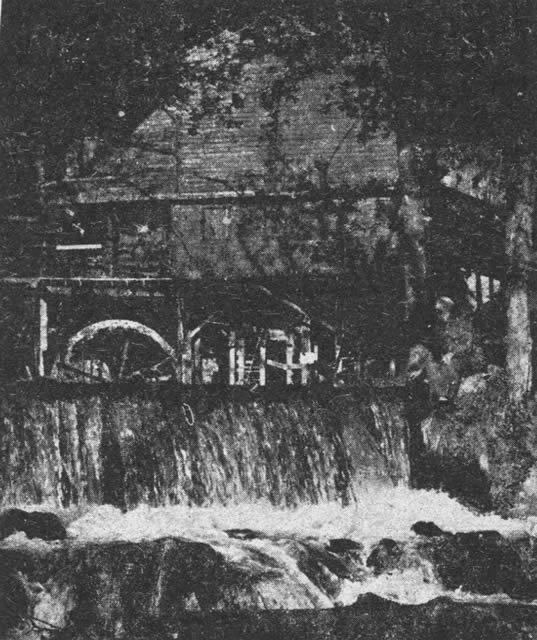Volume 3, Number 9 - Fall 1969
Aid-Hodgson Water Mill In Ozark County
Grinds Meal and Flour Daily
by Ruby M. Robins

Aid-Hodgson Mill, operating daily to produce thousands of pounds of meal and flour through the year, has come to be a symbol of the pioneer water mill in Missouri.
One of the most productive of Missouri's still operating water mills, Aid-Hodgson is a classic example of the few surviving pioneer mills in the state.
The handsome, three-story, red mill, with its millpond and waterfall, fed by one of the state's larger springs, is often used by the state in tourist literature and this year it decorates the back cover of the 1968 Missouri highway maps. The waterfall is also used on the back cover of the current issue of the Missouri Conservationist.
Situated in the valley of Bryant Creek, famed fishing float stream, the mill was built by master millwright Alva Hodgson in 1897 near where a pioneer mill was in operation as early as 1861. The Civil War soon forced the close of this enterprize, but it was revived at the war's close by William Holman whose mill was replaced by the present structure.
Through the years, the mill was operated by several owners until 1934, when the late Charles T. Aid of West Plains purchased the property. Now owned by the Aid estate, it has had the double name since the time of purchase in 1934.
The output of the mill, capable of producing 3,000 pounds of flour or 2,500 pounds of meal daily, is sold to wholesale and retail grocers throughout the Ozarks and well into north Missouri. Now a huge millwheel turns in the pond as a tie-in with the past, but power to turn the millstones comes from two turbines. They are driven by the spring whose massive flow is guided by a stone forebay into the openings of the turbines-one of 48 h.p. and the other of 40 h.p.
The original millstones, still in use, were purchased by Hodgson and come from the Pyrenees Mountains of France, one of the prime sources for the hard nodular flint favored for millstones.
The mill produces white and yellow cornmeal, whole wheat cereal, and bran, whole wheat, unbleached, rye, and pancake flours. These meals and flours are sold at the mill.
A tentative exploration tunnel runs a short distance into the cave which runs under the imposing limestone bluff against which the mill stands.
Exploration is more-or-less at a standstill as it is feared damage might be done to the spring which powers the mill during the necessary dynamiting that would have to be done to open blocked tunnels.
On a second level walkway, once the "front" yard of the house that stood where the cafe is now, are a barbeque oven and picnic areas. Here and at a lower cliff walk are plantings of flowers which grow along with wildflowers and trailing vines, and at the entrance to the mill a huge oak clings to the bluff with roots as large as saplings exposed along the rock.
The mill branch below the fall is stocked with trout from the Rainbow Trout and Game Ranch and visitors can fish the fast
[3]
flowing strain at a nominal fee during the summer season. There is also a nominal fee for campground service and electrical hook ups. But the picnic facilities and tour of the mill are free.
Float fishing parties on the Bryant often camp overnight at the mill campground. There are spaces for eight campers.
From January, to May, more than 3,000 persons visited the mill. Many photographs are made and a large number of visitors make sketches. Some bring their easels and oils and paint the mill from a favorite spot while others use water colors and still others use charcoal or pastels.
In a field southwest of the mill and across the Bryant is a wild azalea bed which draws a great deal of interest when they bloom in late April or early May.
Served by Sycamore post office, also founded by Alva Hodgson, the mill is situated on Highway 181, known as the scenic old mill drive of the Ozarks. Each year the Gainesville
Chamber of Commerce sponsors a springtime dogwood tour of mills along or near this route including Zanoni, Rockbridge and extending to Route PP to include Dawt Mill, also still in operation and also built by Alva Hodgson.
Leaving the mill on the Bryant for his brother, George Hodgson, to run, Alva Hodgson built Dawt Mill where he stayed for a number of years before going to Henderson, Ark., where he built a cotton gin, now under the waters of Lake Norfork.
When his eyesight began to fail at Henderson, he decided to rejoin his brother at the mill on the Bryant. Though almost blind, he was able to run the mill successfully from memory almost up to the time of his death in 1921.
The creative design of the mill on the Bryant, repeated in Dawt Mill, mark Hodgson as a master builder and engineer and as a shrewd businessman who knew a good location when he saw it.
[4]
This volume: Next Article | Table of Contents | Other Issues
Other Volumes | Keyword Search | White River Valley Quarterly Home | Local History Home
Copyright © White River Valley Historical Quarterly

